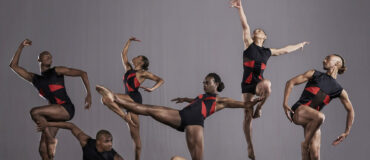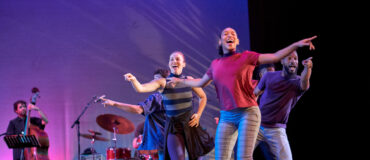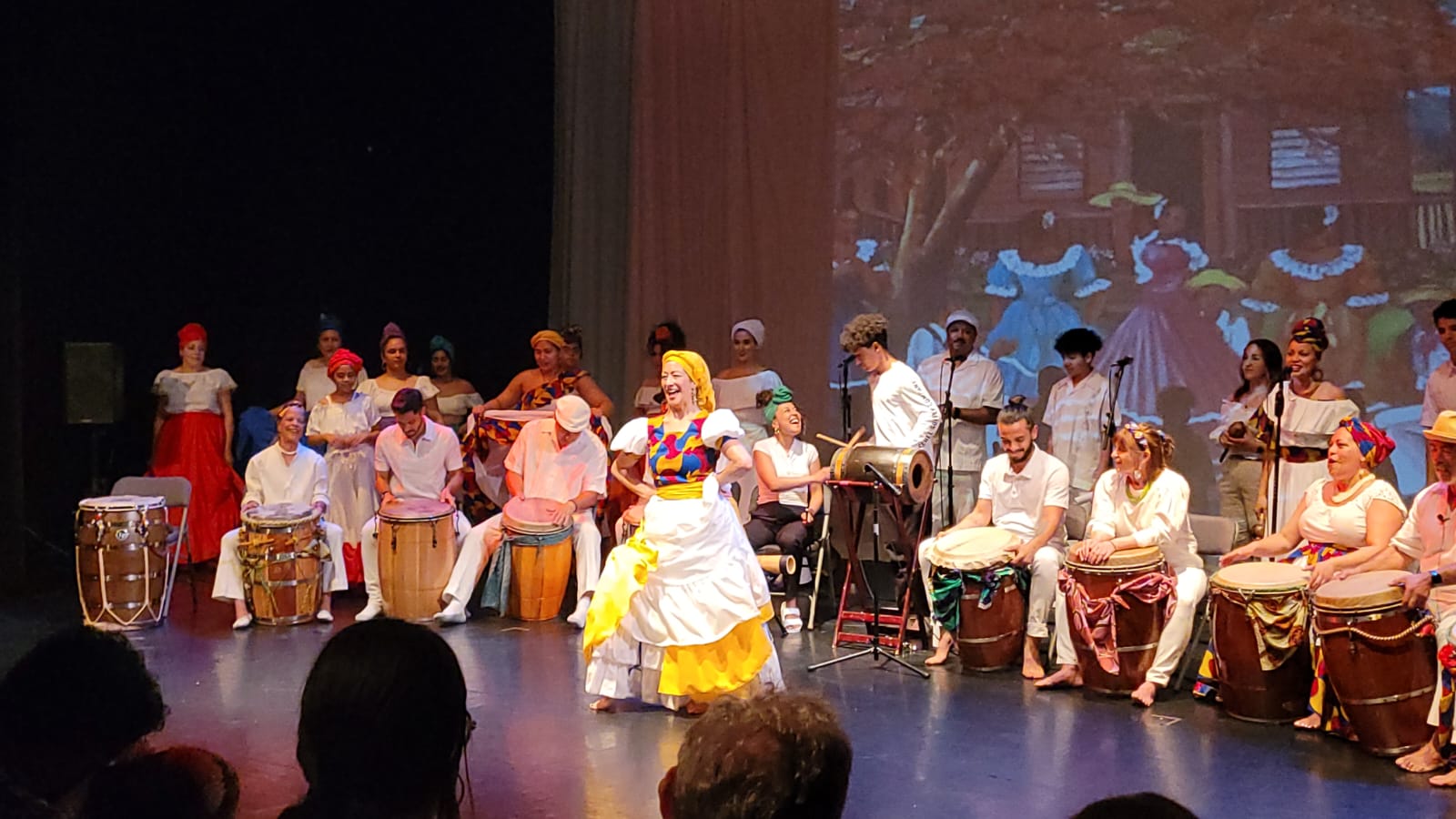Archiving Fellowships Blog: Segunda Quimbamba Folkloric Center, Part 3
By Abdiel Jacobsen
Abdiel Jacobsen is a 2023 Archiving and Preservation Fellow with Segunda Quimbamba Folkloric Center. Read more about the Fellowships here. This is the third part of Abdiel’s blog; read the second part here and the fourth part here.
Meeting 2Q

The five barriles de bomba played by the men and women of the company.
During my first week at Segunda Quimbamba Folkloric Center (SQFC) I had the pleasure of meeting the performance company Segunda Quimbamba, aka 2Q. They meet every first Friday evening of the month. At 6pm, members started arriving for rehearsals on the ground floor of SQFC. I was invited to stay and join the rehearsal and could not pass up the opportunity to meet these incredible people. I folded up the table and moved the archival documents into the corner to clear space for the drums. I was curious about how they would fit everyone in the intimate living room space, but somehow they got 5 barriles de bomba (Bomba drums) to form in a semicircle with the cua (wooden sticks for playing the drums) on a wooden stand nearby, a table with several güiros and maracas and a seating row with a mini sofa, wooden bench, and chairs completing the other half of the semicircle. 2Q members and their families would soon play the güiro, maraca, shekere, cow bell, and guitar while both dancing and singing. Soon it would become a circular, vibrational symphony of rhythmic interplay and vocal elation.
I was greeted with kindness and smiles from each member. Vivian Warfield, the eldest member, is an African-Indigenous American woman from Brooklyn in her mid-70s that had such a vitality to her–she immediately stood out to me. She was very passionate about sharing Afro-Puerto Rican traditions. I remember her excitement when learning about my West African (Ivorian) roots and conversely, how excited I was to learn how active she has been in the African and African diasporic drumming and dance community in NYC for over 50 years. After sharing with her that I was recently introduced to Capoeira and learned how to play the berimbau (an Angolan musical bow with a single steel string and a hollow gourd resonator), she offered her own berimbau as a gift to me; a demonstration of the kind of generosity that exists within this community.

The wooden barrel that the cua (two wooden sticks) are played on with a cow bell attached to the side. The cua are not shown in this picture.
There were over 15 members present–aunts, uncles, parents, grandparents, children and teens. The youngest member was in the 8th grade. It was an intergenerational family affair, both biologically and spiritually, of those who have been adopted into the 2Q family. I got a full introduction to each individual. Everyone mentioned how they found a home at SQFC. It was touching to witness the deep bonds cultivated here through Juan and Nanette’s care. I felt completely safe and welcomed and not at all a stranger. Juan gave an endearing speech about their gratitude for receiving this archiving fellowship award via Dance/USA and for the work I have embarked on with them. I was so humbled to be present among such deeply woven communal fortitude and sincerity. All of the instruments came out and I got to witness the magic of Bomba, “…simultaneously the name of the drum, the dance and the rhythms that encompass the most developed form of Puerto Rico’s drum music” (Cartagena).
They played various Bomba rhythms and their respective songs:
Cuembé: from the southern and western regions of Puerto Rico.
- The song rehearsed: “Cuembé Na Ma”
- Translated as: “Cuembé [rhythm] is what it is.”
Yubá: from the Ponce region of Puerto Rico.
- The song rehearsed: “Suena mi Tambor”
- Translated as: “sound my drum.” It starts as a more somber song about the struggles of slavery then explodes into the affirmation of the drum.
Sicá: from the Santurce region of Puerto Rico.
- The song rehearsed: “Carnaval”
- Translated as: “Carnaval.” Carnival is a popular tradition in Puerto Rico and so is this type of party song and rhythm that expresses it. The lyrics had a constant call and response from the lead singer to the chorus. For example:
| the primo sings | the chorus responds |
| “quando, quando es?” (when, when?) | “ahora, ahora es!”
(now, now!) |
| “yo vi un diablo verde”
(I saw a green devil) |
“sentado en la cocina”
(sitting in the kitchen) |
| “mi mamá que le mande una cebollita” (mom is asking for an onion at market) | “dile que coja la más chiquita”
(tell her to get the smallest one) |
Calindá: from the northern and western regions of Puerto Rico
- The song rehearsed: “Golpe tuyo Calindá”
- Translated as: “Calindá is your beat [rhythm].”
Seis Corrido – from Loíza
- The song rehearsed: “Mercedes”
I learned that practice sessions like these can also be akin to what is called a batey, which is similar to a jam session or cipher with both dancers and musicians present. The energy was vibrant and I felt invigorated by the vibrations of all the synchronized and improvised percussive instruments. I appreciate how each member was encouraged to rotate between various instruments to gain experience practicing them all. Bomba performers and educators Jade Power-Sotomayor and Pablo Luis Rivera write, “…in most bomba settings today women primarily sing and dance while the men play drums, and trans and queer identities are still barely finding space in the batey.” With 2Q, both men and women and those of various sexual orientations all played each instrument, including the drums, demonstrating the inclusive and progressive ethos of 2Q. As a queer, genderfluid, non-binary identifying individual, I felt safe to express myself in this specific practice space, something unusual within my previous exposure to Latino(é) cultural spaces, namely the Salsa dance communities I had engaged with in my young adulthood.
I also got tips from several members on how to dance Bomba and interact with the primo drum, also known as the subidor. The primo follows the dancer and the dancer becomes the conductor of the instrument working in close proximity in order to hear and see each other. With each piquete (improvised dance movements) punctuated by the dancer, the polyrhythmic intensity of the music gradually increases to “.. enliven the beat through fresh and unexpected changes in tone and direction, forming counterpoints by dancing counterbeats, coming back to the main beat again and accelerating, making sure to finish at a peak of intensity prior to the point of exhaustion, leaving everybody wanting more” (Barton). This was daunting at first, but when you participate as a dancer, it is empowering to take such command in relation to the deep resonance of the barriles de bomba. I could feel my Ivorian ancestry within the practice of both movement and music. I planned to stay until 9:00 p.m. but ended up staying until 10:30 p.m. when it finished–four and a half hours total. I was transfixed!
Rhythm is Home – My First Bomba Lesson

The original CD of “Grupo Afro Boricua” directed by William Cepeda, owned by Juan Cartagena.
The week after meeting 2Q, on my way to SQFC I was listening to an album titled “Grupo Afro Boricua” directed by William Cepeda, one of Juan Cartagena’s colleagues in Bomba (Juan previously wrote essays for William´s book on Puerto Rican music in the diaspora). I immediately gravitated to it and started to identify the various rhythms I had learned at 2Q’s rehearsal including yubá, which stood out to me most. Later in the afternoon Juan gave me my first Bomba music lesson and commenced with yubá. The rhythm felt like home. Juan explained that yubá is a grounding rhythm because it is predominantly struck with your dominant hand (if right handed, three beats right and one beat left) with emphasis on the bass with the downbeat. I learned how to play yubá on the barril, cua, and maraca. Each had their distinct qualities of sound and hand-body coordination. The cua was sharp and piercing; the maraca tingled and jingled like a wave of sound, the barril resonated deep in the chest, unearthing vibrations in and under my soul/soles. When all three were put together you could feel a synchronicity of rhythmic sound waves enveloping both the space and your body. It was meditative.
At the same time, I had to pay close attention to the rhythm and keep a steady, constant flow, which is much harder than it sounds. There were several times when I would get off the beat and have to get back in sync. That is part of the training–how to stop and how to rejoin. I kept thinking that every dancer would greatly benefit from learning how to play the music they dance to, especially social dancers in improvisation-based forms where music and dance play off one another. It helps so much to understand the reason why movements are placed and expressed in specific ways because of the rhythmic framework from which it is born.
We then got up and danced, led by Nanette, and after playing the rhythms I actually felt more settled in my body. It’s like I absorbed the musical information in my cells and this new cellular information formed somatic intelligence that allowed me to execute the Bomba dance steps with ease. A new neighbor of SQFC, Jessica, came over to introduce herself in-person and she ended up joining the session impromptu. She is half Puerto Rican and had been exposed to Bomba and Plena traditions before, although it was her first time actually learning and playing it, like me. We both got up and danced with Nanette teaching us yubá steps. I desperately wanted to dance with the skirt! Going back to taking inventory of the cassette tapes after our drum and dance session, I realized I needed these breaks from archiving to connect to the cultural practices which are being archived in the first place. This brought up the questions: should archivists be engaged in the cultural practices of the communities they are archiving? In dance archiving particularly, does embodiment of the cultural practice inform the archiving practice itself? How do we include the rhythms and movement structure into the actual archive?
Cited
- Juan Cartagena, “When Bomba Becomes the National Music of the Puerto Rican Nation…,” CENTRO Journal of the Center for Puerto Rican Studies XVI, no. 1 (Spring 2004): 17.
- Jade Power-Sotomayor & Pablo Luis Rivera, “Puerto Rican Bomba: Syncopating Bodies, Histories, and Geographies,” CENTRO Journal of the Center for Puerto Rican Studies XXXI, no. 2 (Summer 2019): 22.
- Halbert Barton, “The Challenges of Puerto Rican Bomba,” in Caribbean Dance from Abakuá to Zouk, ed. Susanna Sloat (University Press of Florida ), 191.
Header image: Dancer: Kiera Colon, 2Q Spring Recital, June 5, 2022. Photo credit: Mimi Montalvo
All other photos courtesy of the author.
 Abdiel Jacobsen (they/them) is a Hustle dance champion, educator, and community organizer dedicated to the cultural preservation and creative expansion of the New York Hustle partner dance style. As co-founder of “Dance is Life”–a communitarian free public dance party event– Abdiel creates space to facilitate human connection, communal healing, and celebration while revitalizing cultural historical sites where Hustle has been traditionally danced. Abdiel currently teaches their gender neutral approach to partner dance as a Pre Doctoral Lecturer at the University of Washington. They are also a former Fulbright Specialist with the US Dept. of State, Bureau of Educational and Cultural Affairs and a former Principal dancer of the Martha Graham Dance Company. Abdiel is looking forward to deepening their archival practices through the collaboration of the Segunda Quimbamba Folkloric Center and creating communitarian protocol for outreach, collection, and cataloging of crowdsourced materials. For more information on Abdiel: Instagram. Photo Credit: Warren Woo.
Abdiel Jacobsen (they/them) is a Hustle dance champion, educator, and community organizer dedicated to the cultural preservation and creative expansion of the New York Hustle partner dance style. As co-founder of “Dance is Life”–a communitarian free public dance party event– Abdiel creates space to facilitate human connection, communal healing, and celebration while revitalizing cultural historical sites where Hustle has been traditionally danced. Abdiel currently teaches their gender neutral approach to partner dance as a Pre Doctoral Lecturer at the University of Washington. They are also a former Fulbright Specialist with the US Dept. of State, Bureau of Educational and Cultural Affairs and a former Principal dancer of the Martha Graham Dance Company. Abdiel is looking forward to deepening their archival practices through the collaboration of the Segunda Quimbamba Folkloric Center and creating communitarian protocol for outreach, collection, and cataloging of crowdsourced materials. For more information on Abdiel: Instagram. Photo Credit: Warren Woo.
____
We accept submissions on topics relevant to the field: advocacy, artistic issues, arts policy, community building, development, employment, engagement, touring, and other topics that deal with the business of dance. We cannot publish criticism, single-company season announcements, and single-company or single artist profiles. Additionally, we welcome feedback on articles. If you have a topic that you would like to see addressed or feedback, please contact communications@danceusa.org.
Disclaimer: Opinions expressed in guest posts do not necessarily represent the viewpoints of Dance/USA.





